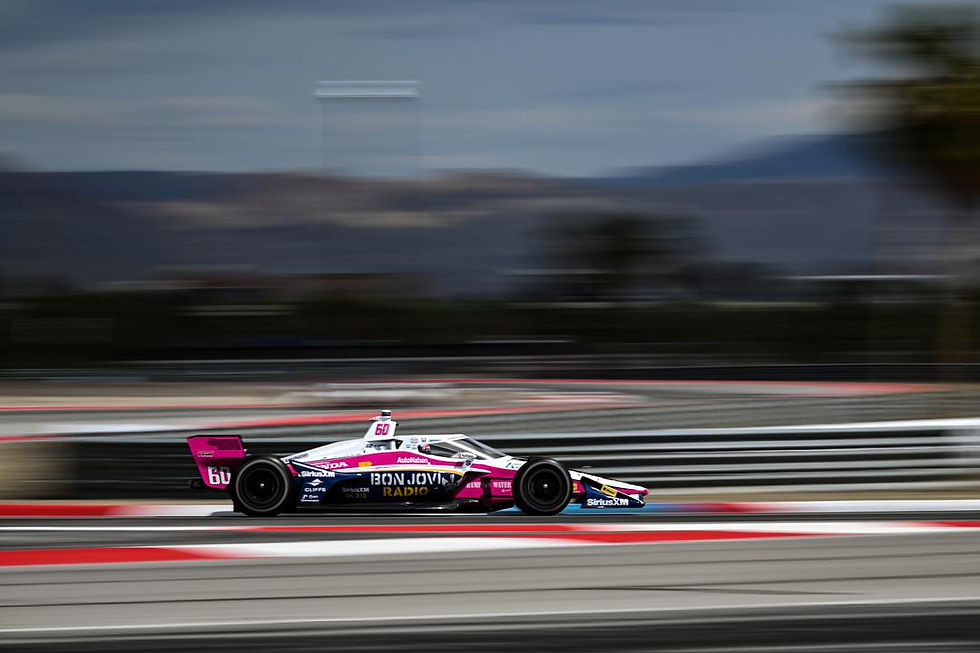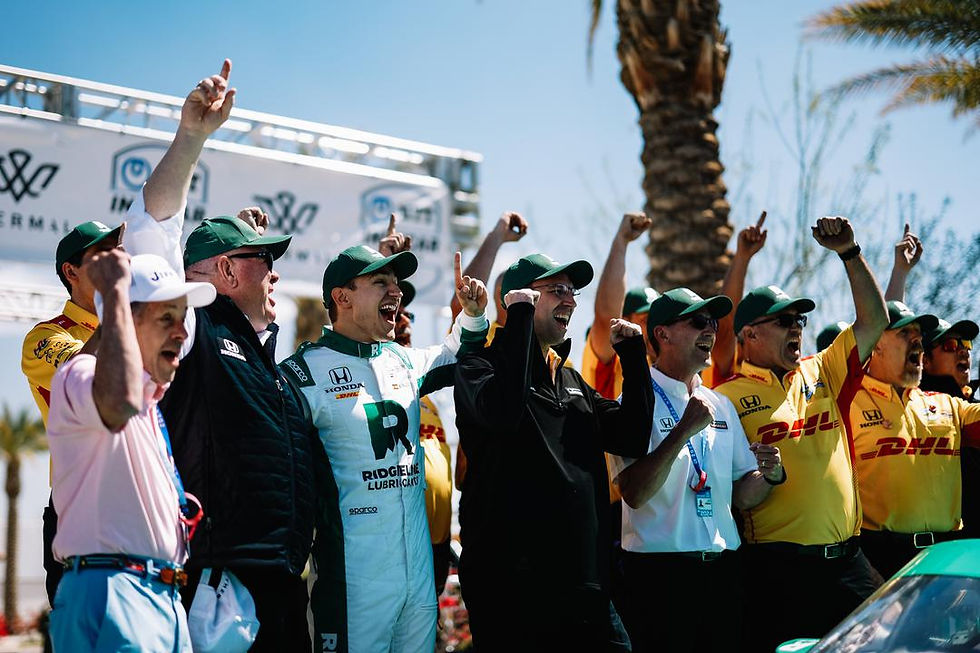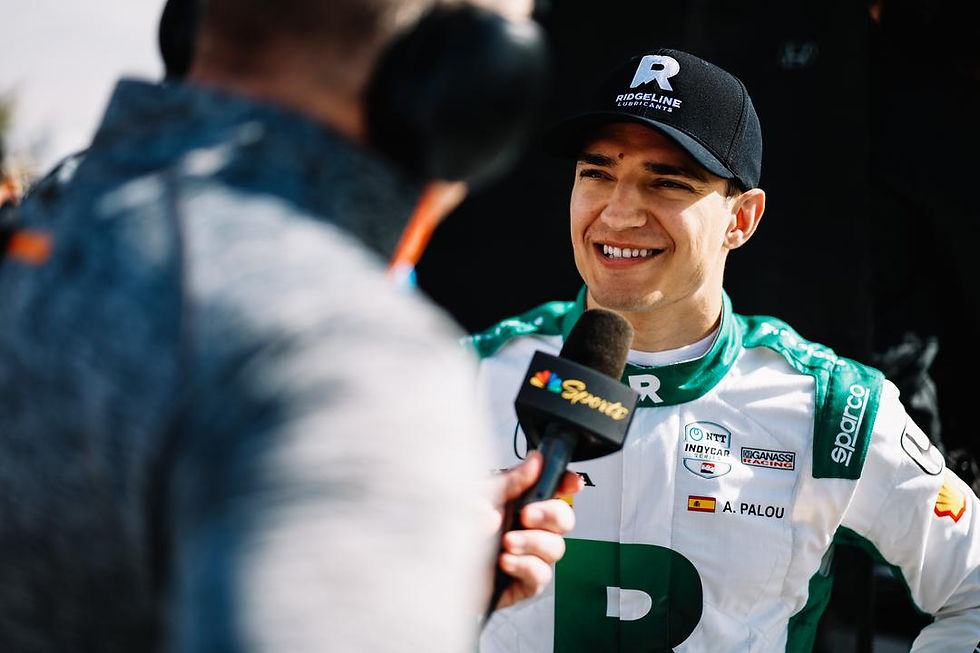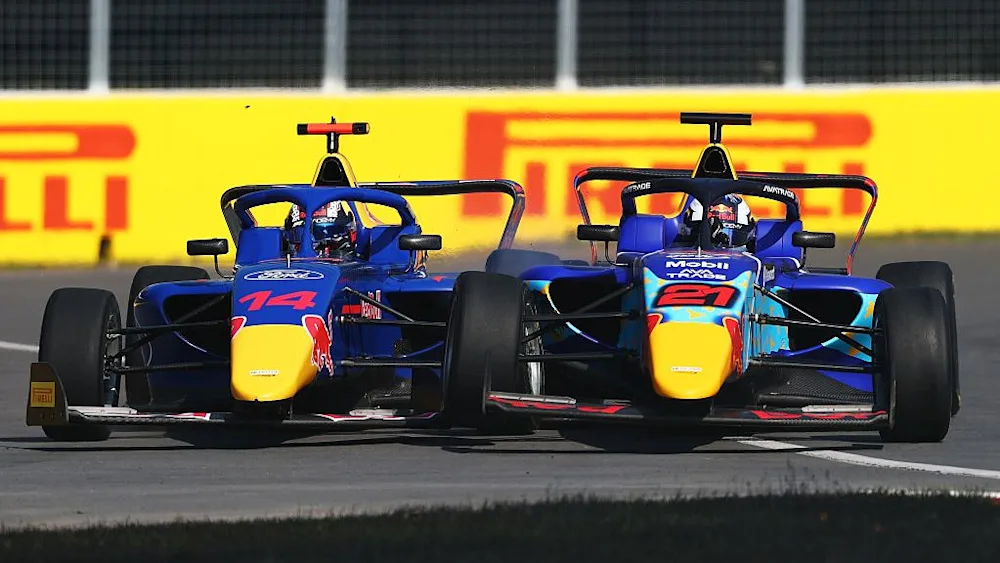IndyCar Drivers’ View: Was the $1 Million Challenge a success?
- Archie O’Reilly

- Mar 25, 2024
- 13 min read
Updated: Jan 3
Written by Archie O’Reilly
The NTT IndyCar Series’ first non-championship event since Surfers’ Paradise in 2008 has come to its conclusion at the exclusive Thermal Club facility in California. In the first event of this kind at Thermal, Alex Palou has come out on top to win $500,000 of a purse of over $1.7 million for the full field - the largest ever non-Indianapolis 500 prize.
The non-points-paying, made-for-television weekend commenced with nine hours of testing on the idyllic 3.067-mile, 17-turn road course, which the series first visited for a pre-season test in 2023. The series used the event as an opportunity for teams to log track time as well as experimenting with a different format.
Following the testing time, split across four sessions on Friday and Saturday, there were two qualifying sessions - the groups having been determined by a draw ceremony on Thursday. These set the field for the two heat races on Sunday, from which the top six of each would transfer to the All-Star Race for a top prize of half-a-million dollars.
The jury is still out on whether the event was a success. There are elements to improve but simultaneously successes. A number of drivers weighed in over the weekend...
“I think it’s great, honestly,” Palou said when DIVEBOMB asked for his views on the event in a post-race media availability. “As fans and as drivers and as part of IndyCar, we want this to grow. We always ask for changes and for updates, to try new stuff even if it doesn’t go as well as we would think or as we want.
“I think it was a success. Everything went smoothly. It was a completely different event than what we’ve been having in IndyCar for the past I don’t know how many years. Everything ran really well. I think it’s awesome that we tried.
“I don’t know if I want this to take over our normal races. I wouldn’t mind, for example, middle of October or beginning of January, once the season is over or before it kicks in, to have a race like this to get everybody excited, to get all the team together, to have a test race that helps everybody. I think it was a success and a win for IndyCar.”
There were numerous festivities and quirks that made for a good environment around the weekend. Will Power played the drums at the draw ceremony, Team Penske teammate and second-place finisher Scott McLaughlin played golf nearby with some of his team and Rinus VeeKay indulged in some pickleball. Ice cream was also a highlight and talk of the town among many.
“Me, Alex, Felix, we all had one,” McLaughlin said on the podium-sitters’ post-race activities. His teammate, Josef Newgarden, was also captured eating an ice cream with his team on the pit stand during a testing track inspection red flag on Saturday.
“I was going to say the food - the food has been amazing,” Palou said of his off-track highlight. Second-place finisher Felix Rosenqvist chimed in: “It’s been pretty laid back - that’s been nice. I think it started very casually, people joking around as they’re eating ice cream.”
A changed qualifying format
For many, the event was made worthwhile by the nine hours of testing before the competitive aspect of the event. With testing time at a premium, it gave a reason to travel to a non-points event if teams were not to make the big money final, used predominantly as time to prepare for the rest of the non-hybrid portion of the year.
The final session pre-qualifying did see the fastest test time laid down by Rahal Letterman Lanigan Racing’s Christian Lundgaard as teams geared up to an adapted qualifying. This included push-to-pass being available for the first time in an IndyCar qualifying session, plus the availability of only one tyre set, as the grids were set for both heat races.
Initially planned to be 12 minutes in length, tyre degradation - a theme of the weekend - meant drivers requested for eight-minute sessions to prevent sitting on pit lane.
“I think that was good,” Palou said of the format. “But I think the product we have in qualifying, it’s amazing. The normal qualifying of having two compounds, you need to not do one really good lap to get the pole, you need to do three to get the Fast 12, then to get to Fast Six. I prefer our normal one.
“I think this worked out pretty good. The push-to-pass, it just adds a little bit of pressure and makes everything so intense. I love it, the feeling of… I’m going to prepare the tires and I’m only going to have one lap. If I have a small lockup, that’s it, your qualifying is done. I think that was pretty good.”
Push-to-pass being available - for 40 seconds - meant drivers were put under pressure to deliver on the optimal lap, on which they deployed the extra power.
“The adrenaline is definitely higher when you’re starting that lap,” Rosenqvist said. “This is it, one-and-done. Maybe a mix of the two could be the ideal scenario. I also love the Fast Six format. It’s super cool - I think the fans enjoy it. It’s not like we're lacking qualifying entertainment as it is.
“It’s fun to try something new. I’m happy they’re trying stuff. That’s kind of why we’re here. We should be open to experimenting a little bit.”
McLaughlin agreed that it was “a good opportunity” to trial some different things. He sided with the fact that push-to-pass being available in qualifying “was cool” and almost reminiscent of his days of a shootout format in V8 Supercars.
“I think that’s awesome from a standpoint of you have to nail the lap on that lap,” he said. “I think that’s a really good opportunity - good and bad - for you to mix up the grid. You just have to nail it. I think it’s definitely something we could think about for the Fast Six, not just here. I feel like we’ve done the same format for a long, long time.
“Don’t get me wrong, it’s great. But could we add something different to what we’ve done in the past to spice up the action.”
The heat races and main event
Sunday marked IndyCar’s first venture into heat racing since Iowa in 2013. One 10-lap or 20-minute - whichever came first - heat race per group determined which 12 drivers made the main 20-lap race, which was split by a 10-minute half time for refuelling but not a change of tyres.
The main event saw drivers drop considerably off the pace to save tyres in the opening half, knowing that the field would be packed back up at the interval. And there will be elements of the format that need adjusting in any future endeavours to put on another similar event.
“Obviously you can tweak stuff like race length,” Rosenqvist said. “Maybe you want to have all cars in the final - things like that. IndyCar has been very open with this event. They told us: ‘Hey, let’s keep an open mind going into this.’ I thought it was great.
“It was so much fun to be out there doing something different that we do every weekend. You learn new things. It’s also a good test for what you can bring to the product going forward.”
Palou had some further ideas to make the racing more intense throughout, rather than a case of drivers approaching the event strategically.
“In some dirt races, every lap they eliminate one car, which is the last car,” he said. “I think that would be pretty cool. Nobody could be managing tyres or anything like that. Everybody should be pushing. I think that would be pretty interesting. Maybe adding the pit stop just so we have more action and you have a little bit more strategies going on.
“But it was cool to see this format, honestly. I was pleased. It looked a lot worse on paper than what it actually was while driving.”
The idea was also raised to the Spaniard about introducing more heat racing into the regular season, which he dismissed and said he “wouldn’t like” to become a thing.
“It’s good to have some special weekends,” he said. “I think it’s too short. I like to race, I like to have issues with the tyres, with the fuel, to have a lot going on throughout the race. I like to sweat and to suffer.
“It felt like you never got into a rhythm. You had 10 laps, then we stopped, then 10 laps, we would stop. It was still a short race. I would be happy with one or two, but I wouldn’t like this to take over five to 10 races.”
Tyres and the racing product
During the half-time break in the middle of the main event, teams were only permitted to add fuel, adjust front and rear wing angles and wickers, adjust tyre pressures and attend to their drivers. Pit stops were only allowed for emergency service with teams unable to pit for tyres.
This compounded the significant tyre degradation issue, with drivers not even putting together 10 successive laps in testing, let alone 20 during the All-Star Race.
On Friday, Kyle Kirkwood hypothesised: “If you’re starting 12th, you might as well circulate slowly for 10 laps, make sure you don’t get lapped.”
This would come to fruition. Kirkwood’s Andretti Global teammate Colton Herta was the first, running as much as 12 seconds off the pace. Others soon joined him, namely Agustin Canapino and to an extent Alexander Rossi, but it was Herta that made the most headway post-break to finish fourth.
“We were looking after our tires at the start, being smart, knowing there’s guys that were going crazily slow, almost too slow I feel like from a racing perspective,” McLaughlin said, with even the leaders cruising by the end of the first 10 laps.
“My heat race, I pushed to the max to see what the limit was, then I saw that that was not the way to do a 20-lap stint,” Palou said. “During the first 10 laps of the main race, we were saving. Everybody was saving. I saw that everybody kept going slower. I was like: ‘All right, I’ll do the same game.’”
There was then the unique challenge of adding maximum fuel on worn tyres, which Palou said made the car “super heavy” and contributed to more aggressive rear degradation in the closing stages. “It was tough to adapt to the completely different car,” he said.
“I thought it was really interesting from a driver’s standpoint because you had to think very big picture all the time,” Rosenqvist, who admitted he had significant degradation in his victorious heat race and had to take a step back in the main race, said. “You were always worried that someone might save the tyres more and have a go at the end.”
Fan reaction was split as to whether cars running off the pace looked a little stupid or added to the entertainment of what was, after all, a made-for-TV event. It did not make for a good racing product across the main race’s first 10 laps, albeit Rosenqvist did say it “was interesting” and thought it could have been a “good” way of growing entertainment.
There was still some elbows-out racing, including hard defence and occasional wheel-banging amid more scope for risk-taking without the championship picture looming large. The widespread view from drivers was that the drive to win never dissipates, even without the incentive of points.
McLaughlin echoed sentiment of the majority on Friday, saying: “It’s funny when you dangle a carrot in front of a bunch of race drivers with a bunch of egos. We want to win regardless of what event we’re in. Whether it’s for a million, four million, 50 cents… we'll just race for that win.”
Palou was one of the more cautious drivers in his approach but admitted the “a win is a win” mentality would always come in.
Romain Grosjean was one driver unhappy with the sacrifices taken with no points on the line. He sustained heavy damage in his heat having been spun by Scott Dixon, ultimately collecting Rinus VeeKay, before the first corner. “Who’s going to pay for the damage?” he said on the NBC broadcast, claiming this was not what he signed up to IndyCar for.
The Thermal Club track
“It’s hard to believe it’s a racetrack,” Rossi said on the opening day of track action.
With a backdrop of palm trees and snow-capped mountains, the Thermal Club is a purpose-built facility for its driving-minded celebrity, corporate executive and motorsport enthusiast members. IndyCar President Jay Frye has confirmed everything has been done from a safety standpoint to make it an FIA Grade Two facility.
“I think from when we were here last time to now, they’ve done a really good job with improvements, safety improvements to get it up to standard,” McLaughlin said. “From the get-go, I generally have enjoyed the track. It’s a challenging, technical track. It takes a lot to get the lap right. When you do, it’s very rewarding.
“I love the area like [turn] eight, nine - long, sweeping corners. It’s a big commitment in these cars. Two people shunted there from pushing the limit too hard. You want that on the track, you want some technical spots. It’s got a little bit of everything. It’s definitely not a gentleman’s track. I think people are jealous of not having a track in their own backyard.”
Rosenqvist described it as “really exciting to drive” and “the most challenging track we’ve been to in a while” but did not see it as too different to other road courses on the calendar. Palou alluded to the challenge of the windy and sandy conditions, which can cause the track to quickly evolve.
“There’s runoff areas but only on like slow-speed stuff, which allows you to find the limits,” the Spaniard continued. “But we saw on the high-speed stuff, there’s no run-off areas there. As soon as you have a moment, you run into the wall. It’s not super easy to pass, but it’s doable.”
An insider’s view for members
One special quirk of the weekend was that Thursday’s draw ceremony also partnered a Thermal Club member with an IndyCar driver or team. This gave them immersive integration, including access to team meetings, question-and-answer sessions, racecraft instruction and use of authentic team gear.
“We had two lovely people,” McLaughlin said. “Gigi, she’s a ball of fun. She was on her stand the whole time - her and her husband. It was an amazing week to have them there. They were there from when we started testing. They had headsets on. They could hear everything we were saying. Hopefully they’re not engineers because they have a lot of our secrets.”
It was initially intended for members to compete in their own race in BMW M2s, with their finishing position determining who they were paired with and $500,000 also going to members. But this concept was abandoned before the event, with many members only amateur drivers and not confident enough to compete.
Don Cusick, Thermal Club member and the brains behind Cusick Motorsports and their Indy 500 efforts with Dreyer & Reinbold Racing, admitted there was a lack of experienced enough drivers and there was not enough time to prepare enough cars either. It could be revisited in the future but the alternative concept of a draw to pair members with teams did work well.
“We gave him a headset all day,” Palou said. “You could see he was on the phone all the time taking pictures and videos. I think it’s awesome that they get to see all the work that there is behind the car. He was super happy in Victory Lane and everything. Hopefully we can have him at some other races and show him a little bit more.”
Earlier in the weekend, Power admitted “it’s fun for them to listen in”, especially considering members are generally motorsport enthusiasts, many living in houses overlooking the track.
“I think it’s cool for them to listen to the debriefs, the changes that we do,” he said. “I wasn’t even aware a guy was listening on the intercom. He would have got an insight into how a session goes in IndyCar. It creates interest, potential sponsors. It’s a good concept. Hopefully we keep doing this sort of thing.”
Should IndyCar return?
The main question is… would there be appetite for IndyCar to return to Thermal?
“I think it all comes down to the support that we get from the club and other tracks,” McLaughlin said. “I think Thermal have just put their backs behind IndyCar for this and created an awesome event - the opportunity for all teams to come out here and earn money, which is an absolute bonus, but also to put on a show, have a test day for two days.
“I think it’s just ultimately up to other people that want to be a part of it. But you got to give props to Thermal to do that. I don’t think you’ll see anything else unless people put up the investment that Thermal has done for us.”
There is also the case of timing. This year’s event happened to be a good gap-filler but drivers do prefer the prospect of a points race to avoid a disjointed calendar. There is no ruling out a test-oriented exhibition event at the right time, though.
“It depends on the timing,” Palou said. “If it’s post-season, it’s great to have an exhibition with no points. If it’s pre-season, it’s great to have an exhibition with no points. I don’t know why this is a non-points race, being the second race of the season. I don’t see why we would do that more in the future and why we would keep this race as a non-points.
“If we come back here, we need to have it as a points race. If we do an exhibition, a proper exhibition, where it’s off the calendar, I think then it makes sense that we don’t put any points.”
There is the issue of granting adequate fan access but Rosenqvist agreed that a further visit could be a points round, reiterating that “this is no different from any other road course” and crediting the infrastructure on offer.
During the early part of the weekend, Rossi said the event is “one hundred percent” a good way to grow the series when asked by DIVEBOMB about the suitability of this sort of made-for-TV event.
“I think we were very surprised and interested when NASCAR, a couple years ago, did the Coliseum thing here in LA, like a made-for-TV event,” he said. “Immediately we’re like: ‘Man, we got to keep up, do things like this.’ I think this is a very good response to that. It’s obviously going to evolve as hopefully we get more opportunities to do these sorts of things.
“We all are very vocal about not liking the gap in the calendar. This does fill that. In a lot of ways it’s a win-win. I don’t see that there’s any downside in terms of putting on a show for fans in a period of time when race cars wouldn’t otherwise be on the track. There’s really no negative.”
The general consensus is that IndyCar deserves a lot of credit for seizing the initiative to put on a unique event with the intention of getting more eyes on the series. And while it was not always perfect, points-paying races are the preference and tweaks will be required if the event is to run again, it was a concept worth putting into practice.



















Comments